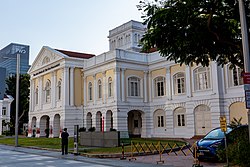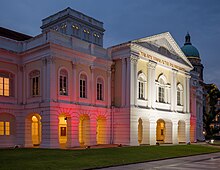The Arts House
| The Arts House | |
|---|---|
 | |
| Former names |
|
| Alternative names | The Arts House at The Old Parliament |
| General information | |
| Status | Completed |
| Architectural style | Neo-Palladian (1875) Victorian (1954) |
| Address | 1 Old Parliament Lane, Singapore 179429 |
| Country | Singapore |
| Coordinates | 1°17′19″N 103°51′03.6″E / 1.28861°N 103.851000°E |
| Construction started | 1826 |
| Completed | 1827 |
| Renovated | 1875, 1901, 1909, 1954 |
| Owner | Government of Singapore |
| Technical details | |
| Floor count | 2 |
| Design and construction | |
| Architect(s) | George Drumgoole Coleman |
| Known for | Former Parliament House of Singapore |
| Renovating team | |
| Architect(s) | John Frederick Adolphus McNair (1875) T. H. H. Hancock (1954) |
| Renovating firm | Public Works Department of Singapore (1954) |
| Website | |
| www | |
| Designated | 14 February 1992 |
| Reference no. | 27 |
The Arts House (formerly the Old Parliament House) is a multi-disciplinary arts venue in Singapore. The venue plays host to art exhibitions and concerts. Built in 1827, the Old Parliament House is the oldest government building and perhaps the oldest surviving building in Singapore.[1] The building was home to the Parliament of Singapore from 1965 to 1999, when it moved to an adjacent new building.
History
The building occupies one of the most historic sites of Singapore. During the refurbishment of the building in 1989, archaeological evidence of older habitation in the area was uncovered with stoneware and earthenware dating back to the 13th and 14th centuries found.[2] The building's river frontage was also where Sir Stamford Raffles was presumed to have landed on 29 January 1819. The area was occupied by Temenggong Abdul Rahman and his family and followers. Raffles would later persuade the Temenggong to move to Telok Blangah in 1823 as he planned for the land to be used for public and administrative purposes.[3]
Design and construction

The building was designed as a Neo-Palladian mansion by architect George Drumgoole Coleman for a Scottish merchant, John Argyle Maxwell.[2] It was intended to be his private residence, however, Maxwell never occupied the house due in part to a dispute over the ownership of the land on which the house was built. Raffles had originally allocated the land for government use in his Town Plan, however, Raffles' successor John Crawfurd issued a permit allowing Maxwell to build a house on the site.[3]
The construction of the Old Parliament House began in 1826 and it was completed in 1827. Maxwell applied for a statutory grant to the site in 1827, and the Resident Councillor of Singapore, John Prince objected as the land was intended for government use.[3] A compromise was then struck whereby Maxwell was granted a 999-year lease in June 1827, but the house would be leased back to the government for a 500 rupees monthly rent.[4] Later Maxwell's residence went up for auction which the colonial government won with a bid of $15,600 Spanish dollars, and the ownership of the courthouse finally transferred to Governor George Bonham and the East India Company on 10 October 1842.[4]
Extension and uses
The building was initially used as a court house, and other government offices including the Land Office also moved into the building.[5] The first court session was held in the central room on the first floor at the front of the building.[4]
In 1839, a new single-storey annex was built on an adjacent plot of land, forming what is now the Former Attorney-General's Chambers building later incorporated into the Parliament House. The Courts then moved into this new building (later on to Empress Place Building), and the vacated space was then used for government offices. The government offices were sited at the building until 1875 when the Supreme Court moved back in after the building was renovated.[4]
The building went through several major extension works. The first was carried out between 1873 and 1875 by John Frederick Adolphus McNair. In 1901, the building was extended towards the Singapore River. Coleman's original design was lost as a result of the extension works. In 1909, two courtrooms were reconstructed and a residence for the Attorney General was built.[2]

The Arts House served as one of the two venues held for the opening of the 14th Parliament of Singapore on 24 August 2020, the other being Parliament House; the multiple venues were used for the first time in Singapore's history as a precaution measure for social distancing as a result of the ongoing COVID-19 pandemic.[6]
As Parliament House
The arches at the porch of the building and Palladian windows of the front façade were part of the original design, although the building currently appeared more Neoclassical in style.[7]
The building was gazetted a national monument on 14 February 1992.[7] On 6 September 1999, the Parliament of Singapore moved into an adjacent new building which faces North Bridge Road.
The Arts House at The Old Parliament

The Arts House at The Old Parliament opened on 26 March 2004 as an arts and heritage centre.[1] The Chambers were converted into a function room where music performances could be held.
See also
References
- ^ a b "Old Parliament House". Singapore Infopedia. National Library Board, Singapore.
- ^ a b c Singapore's 100 Historic Places. Archipelago Press. 2002. pp. 42–43. ISBN 981-4068-23-3.
- ^ a b c Jane Beamish; Jane Ferguson (1 December 1985). A History of Singapore Architecture: The Making of a City. Graham Brash (Pte.) Ltd. pp. 25–27. ISBN 978-9971947972.
- ^ a b c d "Courthouse Architecture". Supreme Court Singapore.
- ^ Tsang, Susan (June 2008). Discover Singapore: The City's History & Culture Redefined. Marshall Cavendish International (Asia) Pte Ltd. p. 71. ISBN 978-9812613653.
- ^ "Parliament opening to be held at Parliament House and Arts House". CNA. Retrieved 23 August 2020.
- ^ a b "Former Parliament House and Annex Building (now The Arts House)". Roots. National Heritage Board. Archived from the original on 8 August 2020.
- Tan, Sumiko (2000) The Singapore Parliament: The House We Built Times Media, Singapore ISBN 981-232-144-6
- Norman Edwards, Peter Keys (1996), Singapore – A Guide to Buildings, Streets, Places, Times Books International, ISBN 981-204-781-6

